Fly, dragonfly, fly
By Ruth D’Alessandro, The Wildlife Gardener Yikes! The Wildlife Gardener nearly trod on a large nymph on the side of the pond today. Carefully noting where it was so I wouldn’t crush it under my waders, I carried on with my late summer task of removing the choking blanket weed that seems to fill the pond overnight if left unchecked. At this time of year the pond has fewer inhabitants, the departed leaving ghostly remains of their time in the nursery:
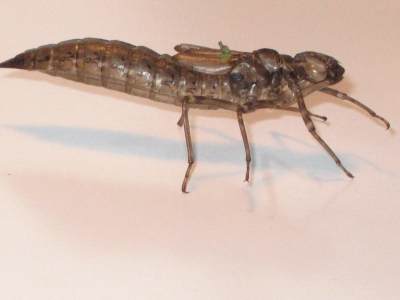
This is an exuvia. It is the dry leftover casing (exoskeleton) of a dragonfly nymph when the dragonfly has emerged and flown away. There were lots of them in the pond. I finished my slubbing, and my thoughts turned to lunch. Before I clambered out of the pond, I had a brief look around to see where the large nymph I had so nearly flattened had gone. I expected it to have plopped back into the pond. Then I noticed a strange green and black creature on a buddleia stem by the pond…
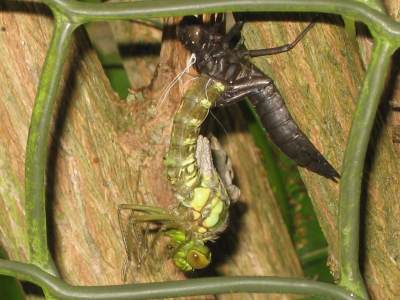
The fat black nymph I avoided earlier had split open, and a pale green box-fresh dragonfly was easing itself out of the casing. Its wings were tiny and scrumpled, and white fibres hung down like burst-open corset laces. These fibres are in fact the breathing tubes (tracheae) that the nymph relied upon for respiration in its aquatic stage. Rather endearingly, the dragonfly was licking its paws as they unpinged from the casing. You can see the deadly barbs on the dragonfly’s legs ” flying prey insects don’t stand a chance once a dragonfly has locked onto them.

I left the dragonfly in peace while I had some lunch. When I returned an hour later, the wings had unfurled, but its body was still curved:
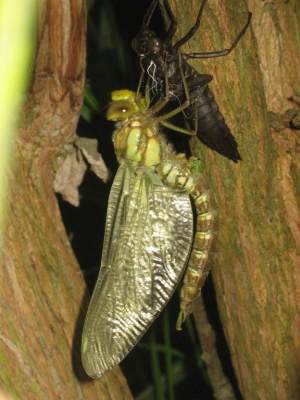
Another hour later and the dragonfly’s abdomen had straightened, and some bluish colour had begun to develop. It had also become aware of me and my prying camera as a possible predator, and shied away slightly, processing, no doubt, thousands of images of me through its compound eyes. My guess was that this dragonfly was a species of Hawker (Aeshna sp.) but I’m happy for one of our readers to give me a proper ID.
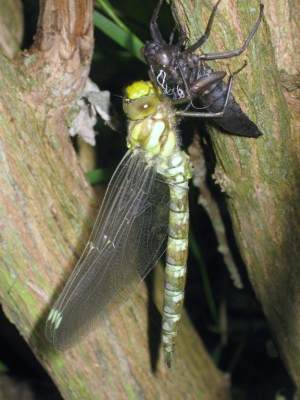
Dragonflies (Odonata) are reckoned to have been present on Earth in some form for around 300 million years. As I watched this brand new one emerge in 2010, I mused upon how many diverse organisms, from the Devonian period to the present day, would have been as fascinated as me watching the unfurling of a dragonfly. But, of course, most of them would have eaten it.
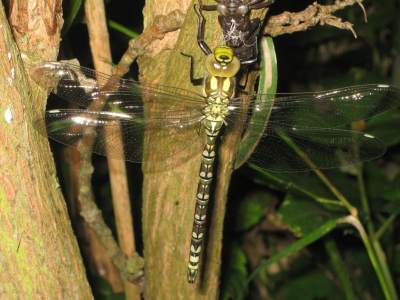
- Spurn Spawn! - 26th February, 2014
- Bluebells on wheels: axles of evil? - 2nd February, 2011
- Raising the ba: Wildlife and the Ancient Egyptian Book of the Dead - 8th January, 2011

Isn’t nature brilliant!
I’m eternally amazed and confused that something so large can crawl out of a shell that size – beautiful.
Yes, Beardie, I think it’s the frogs’ turn next year!
It’s funny how things go. One year I had loads of dragonflies and, consequently, few emerging froglets. The next year I expected more of the same, but had almost no dragonflies and a garden crawling with frogs!
Thanks, Ferny, please link.
Unfortunately haven’t seen the Southern Hawker dragonfly since, but there’s plenty of smaller growing larvae in the pond for next year.
Looks like a lovely Southern Hawker – nice broad shoulder stripes (antehumeral stripes as we’re playing with words) and the dots down the abdomen join into a line at the ‘tail’ end. The Azure Hawker is a Scottish species so we’d need to make a bit of a trek to see one.
What a fantastic photo sequence you’ve taken there – I’ll link in to this page whenever I’m describing ecdysis.
In addition to the excellent Steve Cham guides which Richard mentions, the new 2nd edition WILDGuides British Dragonflies book has a very good section on exuvia/larvae, and has recently become my favourite book for adults as well.
Ha Bill! The downside to ecdysis is you’ll probably only live a maximum of three years and one day….
Now if only I could cast off this old outer shell (ecdysis) and find a shiny new one!
Bill:www.wildramblings.com
Oh! I’m lovin’ these new words! 🙂
Could potentially be the Odonata – when I used to have a pond, the tadpoles would get absolutely clobbered by newts, so predation definitely has an impact.
Speaking of new words, it would be entirely correct to say that your larva has undergone ecdysis, producing an exuvia and that most ephemeral of instars, the teneral imago…
Thanks Bill! I learned a wonderful new word this weekend in connection with emerging things: ecdysis: the casting off of the cuticle/exoskeleton/outer garment.
This gives us ecdysiast – a striptease artist!
Richard – the numbers of frog tadpoles are right down (because of the Odonata?) – will be interesting to see if their numbers decrease with the decrease in food.
What a fascinating post! Wonderful to see the transformation caught by your terrific photographs! Thanks.
bill:www.wildramblings.com
It’s certainly possible – amongst the Hawkers, A. cyanea are noted for colonising garden ponds, but as long as the food’s there, there’s no reason why you wouldn’t get more species turning up, the smaller Darters, etc, in particular. Damsels can colonise more easily because they need smaller quantities of smaller prey – the dragon colonisation may well depend on your tadpoles!
It’s possible to ID the exuviae – Steve Cham & the BDS have published a pair of ID guides, one for dragons and one for damsels
Lisa and Wendy – thanks for your nice comments.
Richard – you are ever-reliable to give me an identification – I’d toyed with it being an azure hawker, but you are spot-on with a southern. A truly beautiful creature – its markings are like Egyptian tomb decorations.
Do you think other species of dragonfly would populate the pond? Damselflies certainly do. I’ve collected 4 more exuviae and they look pretty much identical to the southern’s.
I’ll get in touch with the British Dragonfly Society – thanks for the tip.
On further checking of their website, they’re also looking for photo sequences like this, amongst others – it’s at the bottom of the homepage http://www.dragonflysoc.org.uk/home.html
It’s a Southern Hawker, Aeshna cyanea – a spectacular beast!
The British Dragonfly Society are interested in all dragonfly & Damselfly records – they have online recording forms at http://www.ghmahoney.org.uk/bds/recording/recordentry.aspx
Ruth I love your photos and was fascinated to hear about the lives of dragonflies.
Fascinating and beautiful. It’s amazing what happens under our noses. I must pay more attention!
Steve – 😀 Naturenet – always (rightly or wrongly) expanding the English language for you!
Great shots and good commentary, Ruth (with some interesting new words!)